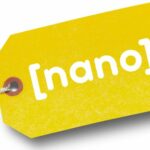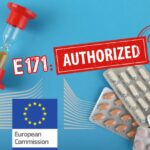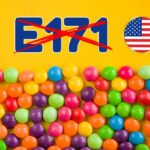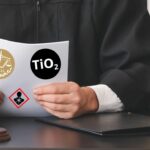
Labeling [nano]

Labeling [nano]
By the AVICENN team – Last modification June 2022
Three categories of products supposed to be labeled “nano”
The requirement for [nano] labeling is mandatory in Europe for three product categories: cosmetics, biocides and food .
[nano] labeling of cosmetics: mandatory since July 2013
The Cosmetics Regulation requires manufacturers to mention the presence of nanomaterials in the list of ingredients of cosmetics, with the term “nano” in square brackets, after the name of the ingredient. In the case of TiO2, we can read for example: Titanium dioxide [nano].
Entered into force since July 2013, this [nano] labeling obligation , applied on a small number of cosmetics, is still very marginally respected by cosmetic brands – sometimes by ignorance of the nano nature of their ingredient(s), sometimes by wait-and-see attitude or even through bad faith.
(nano) labeling of biocides: mandatory since September 2013
The Biocides Regulation also requires that the label indicate the presence of nanomaterials in biocidal products, with the term “nano” in parentheses after the name of the ingredient.
It also requires that “any specific related risks be also mentioned. This provision is an exception, as the labeling obligations in other sectors are limited to the mention of the term “nano”.
However, almost no label (nano) has been observed on products marketed in Europe since 2013, even before the implementation of non-approval measures (2021) and/or classification of nanosilver (planned for 2022).
In June 2022, the Competition, Consumer Affairs and Fraud Prevention Branch (DGCCRF) has announced that it will conduct an investigation in 2021 on so-called “technical” textiles.1Cf. Technical textiles: between innovation and overkill, DGCCRF, 3 June 2022 Two of the six antibacterial or “anti-odor” products analyzed were treated with silver nanoparticles, which are currently being classified because of their risks… and without this information being made available to consumers, contrary to the Biocides Regulation. Following the DGCCRF’s investigation, the two operators marketing these two products withdrew them from the market. To our knowledge, these are the first checks by national public authorities on the presence of biocidal nanoparticles in non-medical textiles.
[nano] labeling in food: mandatory since December 2014
In the food industry, the INCO Regulation had provided for the obligation to put the word “nano” in square brackets on the label, before the name of the ingredient concerned, from the end of 2014. However, pressure from industry lobbies for a reduction in this obligation has delayed the application of this measure. The hurdle was legally cleared in October 2015, with the passage of the Novel Foods (“Novel Foods”) Regulations.
However, almost no mention [nano] appears on the lists of ingredients of food products sold in supermarkets, as shown by several surveys conducted first in France2See in particular:
– Nanoparticles in food: dangerous, useless and uncontrolled, a moratorium is needed, Agir pour l’environnement, Press kit, 15 June 2016
– Stop to nanoparticles, 60 Millions de consommateurs, Monthly – n° 529 – September 2017 (published on August 27, 2017)
– Nanoparticles – Attention, elles se cachent partout, Que Choisir, Mensuel n° 566, February 2018then abroad (in Germany3See in particular:
– Hintergrundpapier zu den BUND-Tests bei Wrigleys-Kaugummi und Jacobs-Cappuccino-Pulver , BUND (Friends of the Earth Germany), September 2018
– Presence of titanium dioxide in Dr.Hauschka products Oetker in Germany, Foodwatch, August 2019in Italy4Cf. Nanoparticelle di additivi negli alimenti. Chidiamo il bando dell’E171Altroconsumo, May 2019in Belgium5Cf. “Nanomaterials – Everywhere without us knowing it,” Health Test No. 151, June 2019. and in Spain6Cf. “Comemos nanopartículas sin saberlo,” OCU-Compra Maestra No. 449, July-August 2019).
In 2017 and 2018, the DGCCRF (fraud control) revealed the results of its analyses, which confirmed those published by the associations mentioned above: in almost all the food products tested, nanoparticles were detected… without any mention on the label [nano]. UFC Que Choisir filed complaints with the Paris High Court in February 20187Cf. 9 complaints from UFC-Que Choisir against food and cosmetics manufacturers, Que Choisir, January 2018 – still awaiting investigation several years later!
The obligation of “nano” labeling is very insufficiently implemented
Of the three sectors concerned by mandatory [nano] labeling , it is the cosmetics sector in which we observe the most mentions [nano] – currently, more for sun creams than for make-up products. Actually, the cosmetics sector is not particularly exemplary, far from it: the controls carried out by associations or the DGCCRF since 2016 show that each year, many cosmetics contain nanoparticles but are not labeled [nano].
Please note that in other EU Member States, there are no controls by public authorities.
One of the most common arguments for not labeling? Depending on the sector considered (cosmetics, biocide, food), the “nanomaterials” to be labeled are not defined in the same way, which can complicate the qualification (“nano” or not) of substances from suppliers who do not always know for which application(s) the substances they sell will be used:
- the definition of “nanomaterial” that applies for the “nano” labeling requirement in biocides includes a threshold of 50% of particles (by number) with at least one external dimension between 1 nm and 100 nm
- This is not the case for the definitions that apply to cosmetics and food, which do not contain a threshold, but other concepts (such as solubility or bio-persistence for the definition applicable to nanomaterials in cosmetics).
Will the revision of the European recommendation on the definition of the term “nanomaterial” (to be implemented in 2022) lead to the harmonization of these definitions in the various Community regulations, regardless of the sector? This objective, legitimate in itself, has been used as an argument by companies or their federations to explain the absence of labeling, on the grounds that the current definitions could be changed as a result of the revision. Many companies have thus played the wait-and-see card since 2013-2014, by not applying an obligation of “nano” labeling, despite it being written in the law. They have thus “gained” at least a decade of not labeling, this without any reaction from the European Commission…
However, some brands are more careful today than they were a decade ago; the most cautious not only ask their suppliers for attestations of the “non-nano” nature of the ingredients they buy from them, they also conduct tests on their own.
For the other sectors, the silence of the industrialists prevails
Apart from these obligations imposed by Europe, little information is available from manufacturers about the presence of nanomaterials in products not covered by the above-mentioned regulations, but to which we are widely exposed: textiles, detergents, plant protection and veterinary products (including animal feed), paints, toys, drugs and medical devices, for example.
There is still a lot of vagueness (even taboo) about their presence, their nature, but also about the risks associated with them.
Behind the reluctance of companies to communicate lies the concern to protect commercial or industrial secrecy, the fear of seeing consumers turn away from the products concerned8See in particular on this subject:
– L’innovation à l’épreuve des peurs et des risques, Office parlementaire d’évaluation des choix scientifiques et technologiques (OPECST), 2012
– Nanotechnologies – Risks, opportunities or taboo: what communication for European companies, Novethic, September 2010
– Report of the public meeting of October 27, 2009 of the national public debate on nanotechnologies: L’Oréal and the Federation of Beauty Industries (FEBEA) underline the “anxiety-provoking” effect of nano-labelling, which “could lead to attempts to refuse to buy”
– Nanotechnologies and nanoparticles in food and feed, Afssa (now ANSES), March 2009: “the growing international concern about the risks associated with nanotechnologies has led to the disappearance of references to these nanotechnologies in certain communication media”.and/or the risk of seeing their responsibility engaged in case of problem (a risky bet: the strategy of “leave no trace, can’t get traced” can on the other hand turn against the companies if finally unmasked…).
Those who, on the contrary, rely on the “high tech” and trendy marketing effect of the prefix nano9Cf. the actor’s notebook of the association Sciences et Démocratie realized within the framework of the national public debate on nanotechnologies, 2010 are rather the exception that confirms the rule. Especially since it is, in some cases, products that do not necessarily contain more nanomaterials than others10For example, Ipod-Nano (digital music players), Tata Nano (cars) or Franprix convenience stores, Bultex Nano mattresses, mini-packs of chocolate cereals Kelloggs,…).
Under these conditions, it is difficult to have a precise idea of the consumer products on the market that contain nanomaterials: inventories of nano-products exist, but their reliability is limited.
Towards a generalization of the [nano] labeling obligation?
The 4th National Environmental Health Plan (PNSE 4), published in 2021, provides for “to bring to the European level the implementation of a labeling of the presence of nanomaterials on consumer products that are not yet subject to this obligation, especially for objects in contact with the body”. There is indeed a need for better information about the presence of nanomaterials in the products that surround us.
A strong expectation from the community
The labeling of nanomaterials in consumer products has been called for by many stakeholders aware of nanomaterials for more than fifteen years now:
The [nano] label has been requested by a wide variety of stakeholders:
- informed citizens :
- in 2005 by citizens gathered at a consensus conference in Madison, Wisconsin (USA).11See Report of the Madison Area Citizen Consensus Conference on Nanotechnology, April 24, 2005
- in 2006, in a citizen consultation on environmental and health issues related to the development of nanotechnologies set up by the Association for the Prevention of Atmospheric Pollution(Appa) and Entreprises pour l’Environnement (EPE) with a favorable opinion from industrialists
- at the Citizens’ Conference organized by the Ile de France Regional Council in 2007
- during the national public debate on nanotechnologies in 2009-2010 with numerous questions asked during public meetings and on the debate websiteSee12for example, these questions on the theme “Consumer information, product labeling” on the public debate website http://cpdp.debatpublic.fr/cpdp-nano
- in the survey published in November 2020 by the European Observatory for Nanomaterials13What do EU citizens think about nanomaterials?, EUON, November 2020: “A recent survey carried out in five selected EU countries shows that citizens demand better labelling of everyday products containing nanomaterials and increased awareness of the risks and benefits of products containing nanomaterials.
- elected officials:
- the European Parliament since 2009
- the Greens party in France, since 2009
- associations and trade unions:
- during the national public debate in 2009-2010, including AFOC, ATTAC, CFTC, INC, INDECOSA-CGT, CLCV, France Nature Environnement, Force Ouvrière, Vivagora
- In 2012, the European Consumers’ Organisation (BEUC) wrote a report calling for the labelling of nanomaterials in cosmetics to effectively protect consumers14 “Nano-materials in cosmetic products: definition needs to effectively protect consumers”, BEUC, August 2012
- in 2014, AVICENN created the present sheet on “nano” labeling and summarized it in the VeilleNanos Newsletter n° 10/11
- in 2016, labeling was again called for:
- by three petitions: a petition from the “citizen ethics committee” (March 2016), a petition from Mr. Sitbon, a petition from Agir pour l’Environnement (~23,000 signatures in July 2016)
- Francelyne Marano (professor at Paris-Diderot University) in her book
Faut-il avoir peur des nanos?
published by Buchet Chastel in April 2016 - the CFDT in a June 2016 letter sent to public authorities
- the generalization of nano labeling is part of the eleven proposals of the civil society compiled by AVICENN between 2015 and 2017 within the framework of a working group on labeling / restriction of nanomaterials led by the Ministry of Environment15The working group (WG) labeling / nano restriction set up by the Ministry of Ecology has been tasked with developing proposals for a European strategy for the labeling of consumer products containing nanomaterials and for the restriction of dangerous products containing nanomaterials in contact with the skin (especially with children and pregnant women). The creation of this group is the result of a commitment in the roadmap from the 2014 environmental conference (action #67). Two meetings were held in September and October 2015 at the end of which the Ministry of Ecology limited itself to noting the lack of consensus between the participants, which was highly predictable given the diversity of interests represented! At the April 2016 Environmental Conference, it was decided to discuss further work in the NESP3 WG4 on May 19, 2016. AVICENN exceptionally participated to the meeting of this WG4 for the occasion. The continuation of the work has been confirmed. Other meetings were held in 2016 and 2017 without the proposals of the various stakeholders being followed up… until the publication of the PNSE 4 in 2021.
- public institutions…
- … French:
- the CCNE (Comité consultatif national d’éthique) in a 2007 opinion,
- the AFSSET (ancestor of the ANSES) in a report of March 2010
- the Conseil national de la Consommation (CNC) in its opinion on consumer information on the presence of nanomaterials in consumer products of June 2010
- the seven ministries sponsoring the national public debate, in their interministerial communiqué of October 27, 2011,
- the French authorities, in their response to the European Commission on the adaptation of REACH to nanomaterials, in September 201316Cf. Response of the French authorities to the European Commission’s public consultation on the possible revision of the annexes of the REACH regulation to adapt them to nanomaterials, SGAE, September 2013
- Ecology Minister Ségolène Royal, who announced that she would propose to the Environment Council on December 17, 2014 in Brussels that a strategy for labeling everyday consumer products containing nanomaterials be implemented at the European level. The establishment of a working group at the national level to specify these proposals was announced for the first half of 201517Cf. Press Release – The 2014 Environmental Conference, Ministry of Ecology, Sustainable Development and Energy, December 1, 2014 and carried out in the second half of the year (see below).
- the High Council for Public Health (HCSP) in 2022 recommended“to improve public information on the presence of nanomaterials in consumer products through clear labeling (“composcore” according to the HCSP opinion of 08/27/2020 or “toxiscore”) and enforce strict compliance with regulations”18Cf. Global evaluation of the National Health and Environment Plans (2004-2019), HCSP, March 2022.
- … European, including the Joint Research Centre (JRC)19Cf. Considerations on information needs for nanomaterials in consumer products; Discussion of a labeling and reporting scheme for nanomaterials in consumer products in the EU, JRC, April 2014 attached to the European Commission
- … or international, including ISO (International Organization for Standardization) in December 201320Cf. Nanotechnologies – Guidelines for the voluntary labeling of consumer products containing engineered nano-objects, ISO/TS 13830, December 2013 (never applied…)
- … French:
Labeling necessary but not sufficient
Labeling must not lead manufacturers or public authorities to tranfer all responsibilities to the consumer.
According to legal expert Stéphanie Lacour, “Providing the public with satisfactory information on nanotechnologies, the risks they are likely to induce and the composition of the products to which they are exposed in order to enable them to make the most relevant choices, individually and collectively, is a laudable objective and responds to an undeniable social demand. Since the risks associated with nanomaterials remain, in their vast majority, uncertain, the introduction of labeling obligations alone is not a relevant tool.” It must be, according to the jurist, “properly inserted in a more global management of emerging risks – from the adoption of precautionary measures upstream to transparent procedures when products are placed on the market and the implementation of shared vigilance obligations“21See Des tenants et aboutissants de l’étiquetage des nano-produits, Stéphanie Lacour, Bulletin de veille scientifique, ANSES, 2011.
On France Culture in 201422Cf. Les nanos sont-elles toxiques, Science publique program, France Culture, June 20, 2014Stéphanie Lacour warned again that labelling alone, if not accompanied by other measures, would amount to “to make the consumer bear the responsibility of a choice that the industry has made for him upstream or that the public authorities refuse to make in favor or against the marketing of a certain number of products”..
During the same program, Roger Lenglet, author of the book Nanotoxics insisted that: “We are completely out of democracy, on a public health issue where the scandal is already constituted since we put on the market, once again, stuff that we have not sufficiently tested while we had all the indications to be suspicious. We are in a situation where labeling is really the minimum!”
Business to business traceability (B2B labeling) is more necessary than ever to guarantee the sincerity of labeling to consumers (B2C labelling)23Cf. “The challenges of labeling consumer products containing nano-objects,” Françoise Roure, presentation at AFNOR, June 5, 2014.
→ While labeling is necessary, there is now a near consensus that it must be complemented by other information, traceability and supervision actions, such as:
- safety data sheets (SDS), environmental and health declaration sheets (EDS)
- pre-registration for marketing authorization (theoretically mandatory for biocides, cosmetics and food, although practice shows that this is not the case in reality)
- declaration in REACH, in the French R-nano register (which must be improved and made less opaque) and other national registers that should be extended to the European level (before being extended, ideally, to the international level, as a result of the globalization of trade…)
For all intents and purposes, the DGCCRF and the ANSM also pointed out, in July 2021, that the article 1112-1 of the Civil Code establishes a general obligation of information on the part of the seller to the buyer and provides that the seller must inform the buyer of any “information whose importance is decisive for the buyer’s consent”. According to the public authorities, the data transmitted by the supplier should therefore be accompanied by all the relevant data obtained through reliable methods and adapted to the characterization of nanomaterials24Cf. Information note for the application of the definition of nanomaterials in the framework of Regulation (EC) No. 1223/2009 on cosmetic products, DGCCRF & ANSM, 5 July 2021.
NB: The National Institute of Consumption (INC) had proposed in 2009 a number of concrete but relatively heavy measures that are not all implemented today but remain quite relevant:
- obligation for those responsible for placing products containing nanomaterials on the market to provide information to a referral body (this recommendation is partially implemented through the R-nano register),
- implementation of a systematic procedure for providing transparent information to the consumer on the product and its benefit/risk ratio,
- creation of data banks accessible to the general public with information on the products concerned,
- creation of a structure whose mission is to deal with complaints concerning the failure to provide information or the inadequacy of this information in relation to the information systems defined jointly by the players (this joint structure would be composed of representatives of consumers, manufacturers and distributors of products containing nanomaterials; to facilitate consumer access to this structure, a single entry point must be provided).
Any questions or comments? This information sheet compiled by AVICENN is intended to be completed and updated. Please feel free to contribute.
Other news on the topic
Upcoming Nano Agenda

- Scientific conference
- 23rd International conference on Advanced Nanomaterials
- From July 23 to July 25, 2025
- Website: www.advanced-nanomaterials-conference.com

- E-learning program: awareness-raising for personnel who come into contact with nanomaterials during research, formulation, production, maintenance, cleaning, upkeep, etc., as well as safety coordinators or engineers, facility managers, heads of laboratories where nanoparticles are handled.
- Organizers: INSTN Grenoble (CEA)
- On the program:
- 1 – Introduction, definition and characteristics of nanomaterials
- 2 – Toxicity of nanomaterials: the state of knowledge
- 3 – Metrology and characterization of nanomaterials
- 4 – Prevention and protection against nanomaterials in the workplace
- 5 – Quiz: assessment of learning outcomes
- The 2-hour course can be viewed for one month from the date of registration.
- Website: https://instn.cea.fr/…risques-lies-aux-nanomateriaux…

- E-learning program: awareness-raising for personnel who come into contact with nanomaterials during research, formulation, production, maintenance, cleaning, upkeep, etc., as well as safety coordinators or engineers, facility managers, heads of laboratories where nanoparticles are handled.
- Organizers: INSTN Grenoble (CEA)
- On the program:
- 1 – Introduction, definition and characteristics of nanomaterials
- 2 – Toxicity of nanomaterials: the state of knowledge
- 3 – Metrology and characterization of nanomaterials
- 4 – Prevention and protection against nanomaterials in the workplace
- 5 – Quiz: assessment of learning outcomes
- The 2-hour course can be viewed for one month from the date of registration.
- Website: https://instn.cea.fr/…risques-lies-aux-nanomateriaux…
This sheet was originally created in February 2019
Notes and references
- 1Cf. Technical textiles: between innovation and overkill, DGCCRF, 3 June 2022
- 2See in particular:
– Nanoparticles in food: dangerous, useless and uncontrolled, a moratorium is needed, Agir pour l’environnement, Press kit, 15 June 2016
– Stop to nanoparticles, 60 Millions de consommateurs, Monthly – n° 529 – September 2017 (published on August 27, 2017)
– Nanoparticles – Attention, elles se cachent partout, Que Choisir, Mensuel n° 566, February 2018 - 3See in particular:
– Hintergrundpapier zu den BUND-Tests bei Wrigleys-Kaugummi und Jacobs-Cappuccino-Pulver , BUND (Friends of the Earth Germany), September 2018
– Presence of titanium dioxide in Dr.Hauschka products Oetker in Germany, Foodwatch, August 2019 - 4Cf. Nanoparticelle di additivi negli alimenti. Chidiamo il bando dell’E171Altroconsumo, May 2019
- 5Cf. “Nanomaterials – Everywhere without us knowing it,” Health Test No. 151, June 2019.
- 6Cf. “Comemos nanopartículas sin saberlo,” OCU-Compra Maestra No. 449, July-August 2019
- 7Cf. 9 complaints from UFC-Que Choisir against food and cosmetics manufacturers, Que Choisir, January 2018
- 8See in particular on this subject:
– L’innovation à l’épreuve des peurs et des risques, Office parlementaire d’évaluation des choix scientifiques et technologiques (OPECST), 2012
– Nanotechnologies – Risks, opportunities or taboo: what communication for European companies, Novethic, September 2010
– Report of the public meeting of October 27, 2009 of the national public debate on nanotechnologies: L’Oréal and the Federation of Beauty Industries (FEBEA) underline the “anxiety-provoking” effect of nano-labelling, which “could lead to attempts to refuse to buy”
– Nanotechnologies and nanoparticles in food and feed, Afssa (now ANSES), March 2009: “the growing international concern about the risks associated with nanotechnologies has led to the disappearance of references to these nanotechnologies in certain communication media”. - 9Cf. the actor’s notebook of the association Sciences et Démocratie realized within the framework of the national public debate on nanotechnologies, 2010
- 10For example, Ipod-Nano (digital music players), Tata Nano (cars) or Franprix convenience stores, Bultex Nano mattresses, mini-packs of chocolate cereals Kelloggs,…)
- 11See Report of the Madison Area Citizen Consensus Conference on Nanotechnology, April 24, 2005
- 12for example, these questions on the theme “Consumer information, product labeling” on the public debate website http://cpdp.debatpublic.fr/cpdp-nano
- 13What do EU citizens think about nanomaterials?, EUON, November 2020: “A recent survey carried out in five selected EU countries shows that citizens demand better labelling of everyday products containing nanomaterials and increased awareness of the risks and benefits of products containing nanomaterials.
- 14
- 15The working group (WG) labeling / nano restriction set up by the Ministry of Ecology has been tasked with developing proposals for a European strategy for the labeling of consumer products containing nanomaterials and for the restriction of dangerous products containing nanomaterials in contact with the skin (especially with children and pregnant women). The creation of this group is the result of a commitment in the roadmap from the 2014 environmental conference (action #67). Two meetings were held in September and October 2015 at the end of which the Ministry of Ecology limited itself to noting the lack of consensus between the participants, which was highly predictable given the diversity of interests represented! At the April 2016 Environmental Conference, it was decided to discuss further work in the NESP3 WG4 on May 19, 2016. AVICENN exceptionally participated to the meeting of this WG4 for the occasion. The continuation of the work has been confirmed. Other meetings were held in 2016 and 2017 without the proposals of the various stakeholders being followed up… until the publication of the PNSE 4 in 2021
- 16
- 17Cf. Press Release – The 2014 Environmental Conference, Ministry of Ecology, Sustainable Development and Energy, December 1, 2014 and carried out in the second half of the year (see below)
- 18Cf. Global evaluation of the National Health and Environment Plans (2004-2019), HCSP, March 2022
- 19
- 20Cf. Nanotechnologies – Guidelines for the voluntary labeling of consumer products containing engineered nano-objects, ISO/TS 13830, December 2013
- 21See Des tenants et aboutissants de l’étiquetage des nano-produits, Stéphanie Lacour, Bulletin de veille scientifique, ANSES, 2011
- 22Cf. Les nanos sont-elles toxiques, Science publique program, France Culture, June 20, 2014
- 23Cf. “The challenges of labeling consumer products containing nano-objects,” Françoise Roure, presentation at AFNOR, June 5, 2014
- 24









